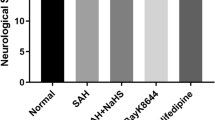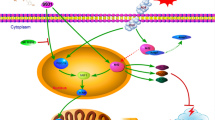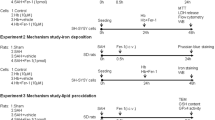Abstract
Increasing studies have demonstrated the neuroprotective effect of hydrogen sulfide (H2S) in central nervous system (CNS) diseases. However, the potential application value of H2S in the therapy of subarachnoid hemorrhage (SAH) is still not well known. This study was to investigate the potential effect of H2S on early brain injury (EBI) induced by SAH and explore the underlying mechanisms. The role of sodium hydrosulfide (NaHS), a donor of H2S, in SAH-induced EBI, was investigated in both in vivo and in vitro. A prechiasmatic cistern single injection model was used to produce experimental SAH in vivo. In vitro, cultured primary rat cortical neurons and human umbilical vein endothelial cells (HUVECs) were exposed to OxyHb at concentration of 10 μM to mimic SAH. Endogenous production of H2S in the brain was significantly inhibited by SAH. The protein levels of the predominant H2S-generating enzymes in the brain, including cystathionineb-synthase (CBS) and 3-mercaptopyruvate sulfur transferase (3MST), were also correspondingly reduced by SAH, while treatment with NaHS restored H2S production and the expressions of CBS and 3MST. More importantly, NaHS treatment could significantly attenuate EBI (including brain edema, blood–brain barrier disruption, brain cell apoptosis, inflammatory response, and cerebral vasospasm) after SAH. In vitro, H2S protects neurons and endothelial function by functioning as an antioxidant and antiapoptotic mediator. Our results suggest that NaSH as an exogenous H2S donor could significantly reduce EBI induced by SAH.











Similar content being viewed by others
References
Miller BA, Turan N, Chau M, Pradilla G (2014) Inflammation, vasospasm, and brain injury after subarachnoid hemorrhage. Biomed Res Int 2014:384342. doi:10.1155/2014/384342
Wang Z, Wu L, You W, Ji C, Chen G (2013) Melatonin alleviates secondary brain damage and neurobehavioral dysfunction after experimental subarachnoid hemorrhage: possible involvement of TLR4-mediated inflammatory pathway. J Pineal Res 55:399–408. doi:10.1111/jpi.12087
Yuksel S, Tosun YB, Cahill J, Solaroglu I (2012) Early brain injury following aneurysmal subarachnoid hemorrhage: emphasis on cellular apoptosis. Turk Neurosurg 22:529–533. doi:10.5137/1019-5149
Yu YP, Chi XL, Liu LJ (2014) A hypothesis: hydrogen sulfide might be neuroprotective against subarachnoid hemorrhage induced brain injury. ScientificWorldJournal 2014:432 318. doi:10.1155/2014/432318
Tewari A, Mahendru V, Sinha A, Bilotta F (2014) Antioxidants: The new frontier for translational research in cerebroprotection. J Anaesthesiol Clin Pharmacol 30:160–171. doi:10.4103/0970-9185.130001
Luo C, Yi B, Chen Z, Tang W, Chen Y, Hu R, Liu Z, Feng H et al (2011) PKGIalpha inhibits the proliferation of cerebral arterial smooth muscle cell induced by oxyhemoglobin after subarachnoid hemorrhage. Acta Neurochir Suppl 110:167–171. doi:10.1007/978-3-7091-0353-1_29
Boscolo E, Pavesi G, Zampieri P, Conconi MT, Calore C, Scienza R, Parnigotto PP, Folin M (2006) Endothelial cells from human cerebral aneurysm and arteriovenous malformation release ET-1 in response to vessel rupture. Int J Mol Med 18:813–819
Lefranc F, Lubicz B, Dewitte O (2007) In vitro evidence of the role of hemoglobin during vasospasm on the modifications of the expression of PKC alpha and zeta. Int J Mol Med 20:415–419
Toda N, Ayajiki K, Okamura T (2009) Cerebral blood flow regulation by nitric oxide in neurological disorders. Can J Physiol Pharmacol 87:581–594. doi:10.1139/y09-048
Kanu A, Whitfield J, Leffler CW (2006) Carbon monoxide contributes to hypotension-induced cerebrovascular vasodilation in piglets. Am J Physiol Heart Circ Physiol 291:H2409–H2414
Yang G, Wu L, Jiang B, Yang W, Qi J, Cao K, Meng Q, Mustafa AK et al (2008) H2S as a physiologic vasorelaxant: hypertension in mice with deletion of cystathionine gamma-lyase. Science 322:587–590. doi:10.1126/science.1162667
Jimenez M (2010) Hydrogen sulfide as a signaling molecule in the enteric nervous system. Neurogastroenterol Motil 22:1149–1153
Zhao W, Zhang J, Lu Y, Wang R (2001) The vasorelaxant effect of H2S as a novel endogenous gaseous K(ATP) channel opener. EMBO J 20:6008–6016
Shibuya N, Tanaka M, Yoshida M, Ogasawara Y, Togawa T, Ishii K, Kimura H (2009) 3-Mercaptopyruvate sulfurtransferase produces hydrogen sulfide and bound sulfane sulfur in the brain. Antioxid Redox Signal 11:703–714. doi:10.1089/ARS.2008.2253
Mancardi D, Penna C, Merlino A, Del Soldato P, Wink DA, Pagliaro P (2009) Physiological and pharmacological features of the novel gasotransmitter: hydrogen sulfide. Biochim Biophys Acta 1787:864–872. doi:10.1016/j.bbabio.2009.03.005
Zoccali C, Catalano C, Rastelli S (2009) Blood pressure control: hydrogen sulfide, a new gasotransmitter, takes stage. Nephrol Dial Transplant 24:1394–1396. doi:10.1093/ndt/gfp053
Li Z, Wang Y, Xie Y, Yang Z, Zhang T (2011) Protective effects of exogenous hydrogen sulfide on neurons of hippocampus in a rat model of brain ischemia. Neurochem Res 36:1840–1849. doi:10.1007/s11064-011-0502-6
Li L, Moore PK (2008) Putative biological roles of hydrogen sulfide in health and disease: a breath of not so fresh air? Trends Pharmacol Sci 29:84–90. doi:10.1016/j.tips.2007.11.003
Kimura Y, Kimura H (2004) Hydrogen sulfide protects neurons from oxidative stress. FASEB J 18:1165–1167
Bian JS, Yong QC, Pan TT, Feng ZN, Ali MY, Zhou S, Moore PK (2006) Role of hydrogen sulfide in the cardioprotection caused by ischemic preconditioning in the rat heart and cardiac myocytes. J Pharmacol Exp Ther 316:670–678
Luo Y, Liu X, Zheng Q, Wan X, Ouyang S, Yin Y, Sui X, Liu J et al (2012) Hydrogen sulfide prevents hypoxia-induced apoptosis via inhibition of an H2O2-activated calcium signaling pathway in mouse hippocampal neurons. Biochem Biophys Res Commun 425:473–477. doi:10.1016/j.bbrc.2012.07.131
Jha S, Calvert JW, Duranski MR, Ramachandran A, Lefer DJ (2008) Hydrogen sulfide attenuates hepatic ischemia-reperfusion injury: role of antioxidant and antiapoptotic signaling. Am J Physiol Heart Circ Physiol 295:H801–H806. doi:10.1152/ajpheart.00377
Florian B, Vintilescu R, Balseanu AT, Buga AM, Grisk O, Walker LC, Kessler C, Popa-Wagner A (2008) Long-term hypothermia reduces infarct volume in aged rats after focal ischemia. Neurosci Lett 438:180–185. doi:10.1016/j.neulet.2008.04.020
Kamat PK, Kalani A, Givvimani S, Sathnur PB, Tyagi SC, Tyagi N (2013) Hydrogen sulfide attenuates neurodegeneration and neurovascular dysfunction induced by intracerebral-administered homocysteine in mice. Neuroscience 252:302–319
Wang Y, Gao A, Xu X, Dang B, You W, Li H, Yu Z, Chen G (2015) The Neuroprotection of Lysosomotropic Agents in Experimental Subarachnoid Hemorrhage Probably Involving the Apoptosis Pathway Triggering by Cathepsins via Chelating Intralysosomal Iron. Mol Neurobiol (in press)
Wang Y, Zhao X, Jin H, Wei H, Li W, Bu D, Tang X, Ren Y et al (2009) Role of hydrogen sulfide in the development of atherosclerotic lesions in apolipoprotein E knockout mice. Arterioscler Thromb Vasc Biol 29:173–179. doi:10.1161/ATVBAHA.108.179333
Wang Z, Chen G, Zhu WW, Bian JY, Shen XO, Zhou D (2010) Influence of simvastatin on microthrombosis in the brain after subarachnoid hemorrhage in rats: a preliminary study. Ann Clin Lab Sci 40:32–42
Pacifici M, Peruzzi F (2012) Isolation and culture of rat embryonic neural cells: a quick protocol. J Vis Exp e3965. doi:10.3791/3965
Li H, Huang S, Wang S, Zhao J, Su L, Zhao B, Zhang Y, Zhang S et al (2013) Targeting annexin A7 by a small molecule suppressed the activity of phosphatidylcholine-specific phospholipase C in vascular endothelial cells and inhibited atherosclerosis in apolipoprotein E(−)/(−)mice. Cell Death Dis 4:e806. doi:10.1038/cddis.2013.317
Meguro T, Chen B, Lancon J, Zhang JH (2001) Oxyhemoglobin induces caspase-mediated cell death in cerebral endothelial cells. J Neurochem 77:1128–1135
Kamat PK, Kalani A, Tyagi SC, Tyagi N (2014) Hydrogen Sulfide Epigenetically Attenuates Homocysteine-Induced Mitochondrial Toxicity Mediated through NMDA Receptor in Mouse Brain Endothelial (bEnd3) Cells. J Cell Physiol. doi:10.1002/jcp.24722
Li H, Wang Y, Feng D, Liu Y, Xu M, Gao A, Tian F, Zhang L et al (2014) Alterations in the time course of expression of the Nox family in the brain in a rat experimental cerebral ischemia and reperfusion model: effects of melatonin. J Pineal Res 57:110–119. doi:10.1111/jpi.12148
Jiao PF, Zhao BX, Wang WW, He QX, Wan MS, Shin DS, Miao JY (2006) Design, synthesis, and preliminary biological evaluation of 2,3-dihydro-3-hydroxymethyl-1,4-benzoxazine derivatives. Bioorg Med Chem Lett 16:2862–2867
Sehba FA, Pluta RM, Zhang JH (2011) Metamorphosis of subarachnoid hemorrhage research: from delayed vasospasm to early brain injury. Mol Neurobiol 43:27–40
Kuhn AL, Balami JS, Grunwald IQ (2013) Current management and treatment of cerebral vasospasm complicating SAH. CNS Neurol Disord Drug Targets 12:233–241
Nana-Sinkam SP, Lee JD, Sotto-Santiago S, Stearman RS, Keith RL, Choudhury Q, Cool C, Parr J et al (2007) Prostacyclin prevents pulmonary endothelial cell apoptosis induced by cigarette smoke. Am J Respir Crit Care Med 175:676–685
Sasaki T, Kikkawa Y (2013) Proposed mechanism of cerebral vasospasm: our hypothesis and current topics. Acta Neurochir Suppl 115:53–56. doi:10.1007/978-3-7091-1192-5_12
Wang Y, Jia J, Ao G, Hu L, Liu H, Xiao Y, Du H, Alkayed NJ et al (2014) Hydrogen sulfide protects blood–brain barrier integrity following cerebral ischemia. J Neurochem 129:827–838. doi:10.1111/jnc.12695
Acknowledgments
This work was supported by grants from the National Natural Science Foundation of China (No. 81371279, 81422013, 81400949, and 81471196), Jiangsu Province’s Outstanding Medical Academic Leader program (No. LJ201139), Scientific Department of Jiangsu Province (No. BL2014045), and Suzhou Government (No. LCZX201301, SZS201413, and SYS201332), and A Project Funded by the Priority Academic Program Development of Jiangsu Higher Education Institutions.
Author Contributions
Gang Chen and Zhengquan Yu conceived and designed the study, including quality assurance and control. Yonghua Cui, Xiaochun duan, and Haiying Li performed the experiments and wrote the paper. Baoqi Dang and Jia Yin designed the study’s analytic strategy. Yang Wang helped conduct the literature review and prepare the “Materials and Methods” section of the text. Anju Gaoi reviewed and edited the manuscript. All authors read and approved the manuscript.
Author information
Authors and Affiliations
Corresponding authors
Additional information
Yonghua Cui, Xiaochun Duan and Haiying Li contributed equally to this work.
Rights and permissions
About this article
Cite this article
Cui, Y., Duan, X., Li, H. et al. Hydrogen Sulfide Ameliorates Early Brain Injury Following Subarachnoid Hemorrhage in Rats. Mol Neurobiol 53, 3646–3657 (2016). https://doi.org/10.1007/s12035-015-9304-1
Received:
Accepted:
Published:
Issue Date:
DOI: https://doi.org/10.1007/s12035-015-9304-1




